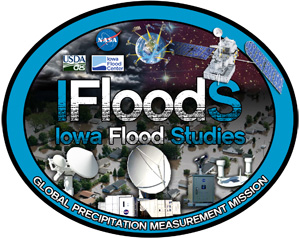
The objective of integrated hydrologic ground validation activities supporting the Global Precipitation Measurement Mission (GPM) is to help validate satellite-based science algorithms in challenging locations, geographies, and types of precipitation. The Iowa Flood Studies (IFloodS) experiment was conducted in the central to northeastern part of Iowa in Midwestern United States during the months of April-June, 2013.
 Specific science objectives and related goals for the IFloodS experiment can be summarized as follows:
Specific science objectives and related goals for the IFloodS experiment can be summarized as follows:
- Quantify the physical characteristics and space/time variability of rain (rates, DSD, process/”regime”) and map to satellite rainfall retrieval uncertainty.
- Assess satellite rainfall retrieval uncertainties at instantaneous to daily time scales and evaluate propagation/impact of uncertainty in flood-prediction.
- Assess hydrologic predictive skill as a function of space/time scales, basin morphology, and land use/cover.
- Discern the relative roles of rainfall quantities such as rate and accumulation as compared to other factors (e.g. transport of water in the drainage network) in flood genesis.
- Refine approaches to “integrated hydrologic GV” concept based on IFloodS experiences and apply to future GPM Integrated GV field efforts.
These objectives were achieved via the deployment of the NASA NPOL S-band and D3R Ka/Ku-band dual-polarimetric radars, University of Iowa X-band dual-polarimetric radars, a large network of paired rain gauge platforms with attendant soil moisture and temperature probes, a large network of both 2D Video and Parsivel disdrometers, and USDA-ARS gauge and soil-moisture measurements (in collaboration with the NASA SMAP mission). These measurements were used to complement existing operational WSR-88D S-band polarimetric radar measurements, USGS streamflow, and Iowa Flood Center stream monitoring measurements.
Coincident satellite datasets were also archived from microwave imaging and sounding radiometers flying on NOAA, DMSP, NASA, and EU (METOP) low-earth orbiters, and rapid-scanned IR datasets collected from geostationary (GOES) platforms. Collectively these observational assets provided a means to create high-resolution temporal and spatial ground “reference” rainfall and stream flow datasets. The ground reference radar and rainfall datasets, in turn, provide a means to assess uncertainties in both satellite algorithms (physics) and higher level data products. Subsequently, the impact of uncertainties in these data can be evaluated in coupled weather, land-surface, and distributed hydrologic modeling frameworks as they relate to flood prediction.






